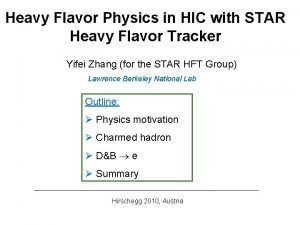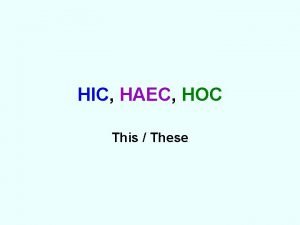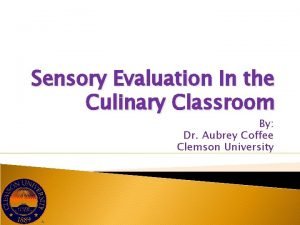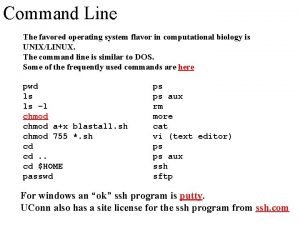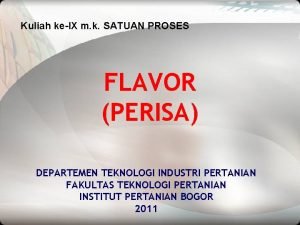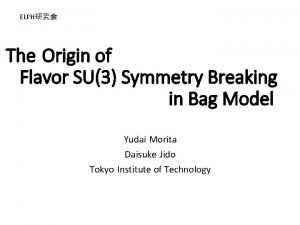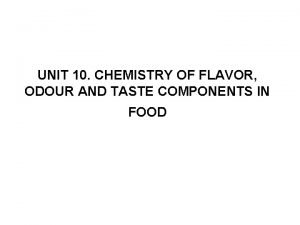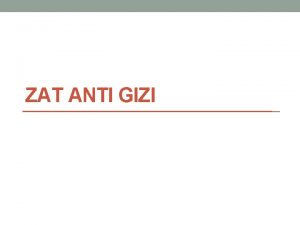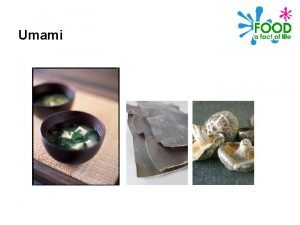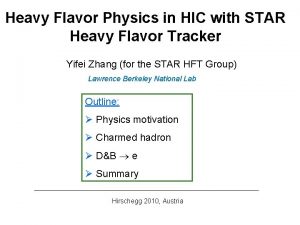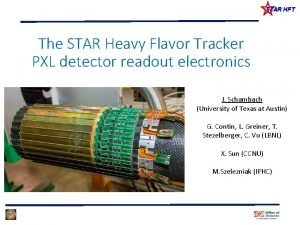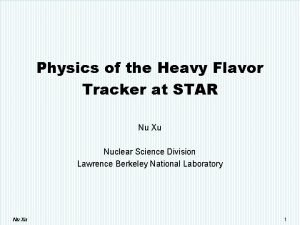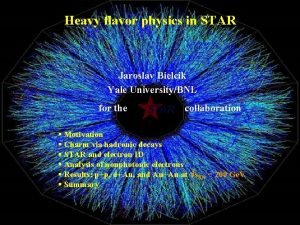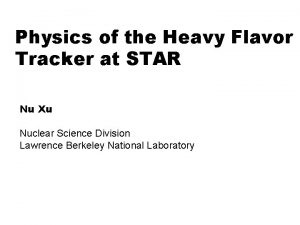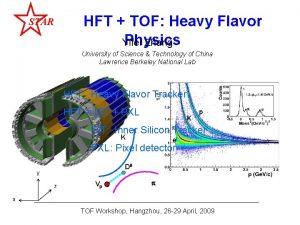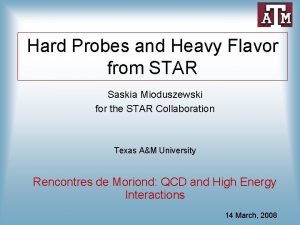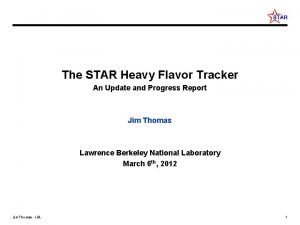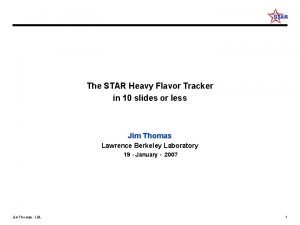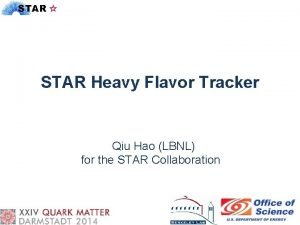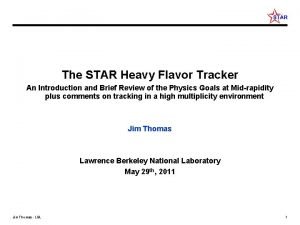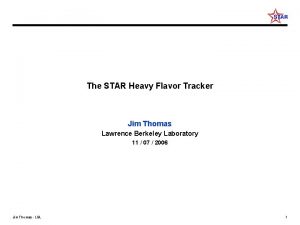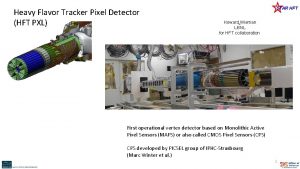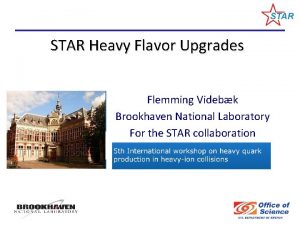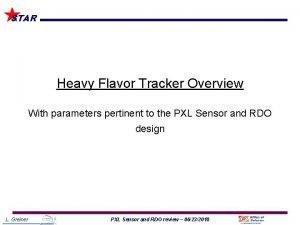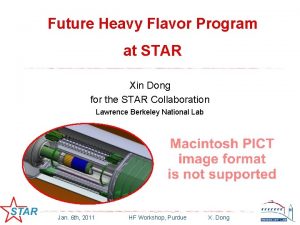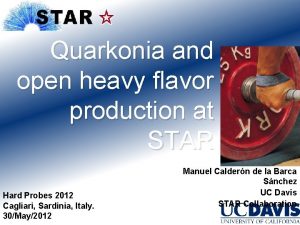Heavy Flavor Physics in HIC with STAR Heavy
























- Slides: 24

Heavy Flavor Physics in HIC with STAR Heavy Flavor Tracker Yifei Zhang (for the STAR HFT Group) Lawrence Berkeley National Lab Outline: Ø Physics motivation Ø Charmed hadron Ø D&B e Ø Summary Hirschegg 2010, Austria

Partonic energy loss at RHIC STAR: Nucl. Phys. A 757, 102(2005). Light quark hadrons strongly suppressed in central Au+Au collisions. Jet quenching: The away-side correlation in back-to-back ‘jets’. How about heavy quarks? Explore p. QCD in hot dense medium RAA(c, b) measurements are needed! 29 November 2020 Yifei Zhang LBNL 2

Heavy quark energy loss STAR PRL 98 (2007) 192301 E-loss: b < c < q The RAA of single electron from heavy flavor decay is suppressed as strong as that of light flavor hadrons at high p. T (> 6 Ge. V/c). 1. 2. Directly measure D-meson RAA Separately measure RAA of D e & B e Heavy quark energy loss mechanism, interactions with hot dense medium. 29 November 2020 Yifei Zhang LBNL 3

Partonic collectivity at RHIC STAR: preliminary STAR: QM 2009 Low p. T (≤ 2 Ge. V/c): hydrodynamic mass ordering High p. T (> 2 Ge. V/c): number of quarks ordering s-quark hadron: smaller interaction strength in hadronic medium light- and s-quark hadrons: similar v 2 pattern Collectivity developed at partonic stage! In order to test early thermalization: v 2(p. T) of c- and b-hadrons data are needed! Yifei Zhang LBNL 29 November 2020 4

Charmed baryon c Lee, et. al, PRL 100 (2008) 222301 Ø c yield (rare 10%, small c ~ 60 m, 3 -body decay). Ø measure c/ D 0 ratio enhancement, di-quark? 29 November 2020 Yifei Zhang LBNL 5

Bottom from electron channel Important for understanding the bottom contribution in current NPE measurements. Large systematic errors for both theory (FONLL) and data (STAR e-h correlation). Need improve the measurement accuracy. Measure this ratio directly from spectra. 29 November 2020 Ø No B meson spectra measured. Ø Separately measure B e spectrum will indirectly measure B meson spectrum from its decay kinematics. Ø B e = NPE D e STAR HFT has the capability to measure D 0 decay vertex topologically via hadronic decay 0 channel. Measured D Yifei Zhang LBNL spectrum constrains D e. 6

STAR Detector TOF+TPC+ HFT Large acceptance Mid-rapidity | | < 1 Full barrel coverage 0 < < 2 PXL 29 November 2020 Yifei Zhang LBNL 7

Inner Tracking Detectors HFT SSD IST PXL Inner Field Cage et n n g Ma rn Iro tu e R EA ST 29 November 2020 Outer Field Cage So len oid FG T TPC Volume WEST Yifei Zhang LBNL 8

Inner Tracking Detectors Detector Radius Hit Resolution (cm) R/ - Z ( m - m) Radiation length SSD 23 30 / 857 1% X 0 IST 14 170 / 1700 1. 32 %X 0 8 8. 6 / 8. 6 ~0. 32 %X 0 2. 5 8. 6 / 8. 6 ~0. 32% X 0 PIXEL Ø SSD existing single layer detector, double side trips. Ø IST 500 m x 1 cm strips along beam direction, it guides tracks from the SSD through PIXEL detector. It is composed of 24 liquid cooled ladders equipped with 6 silicon strip-pad sensors. . Ø PIXEL double layers, 18. 4 x 18. 4 m pixel pitch, 2 cm x 20 cm each ladder. Deliver ultimate pointing resolution, hit density for 1 st layer ~ 60 cm. -2 29 November 2020 Yifei Zhang LBNL 9

Simulation Performance pointing resolution in r- to primary vertex for single particles (of K, +, p. ) including all hits in HFT. < 20 m at high p. T. 29 November 2020 Tracking efficiency of single + for 3 pileup hits densities. 1 x. RICHII pile up effect was included in the simulation. Yifei Zhang LBNL 10

Hadronic channels D 0 C STAR HFT has the capability to reconstruct the displaced vertex of D 0 K (B. R. =3. 8%) and c Kp (B. R. =5. 0%, c c =59. 9 m) 29 November 2020 Yifei Zhang LBNL 11

D 0 reconstruction After topological cut - Central Au+Au collisions: top 10% events. - The thin detector allows measurements down to p. T ~ 0. 5 Ge. V/c. 29 November 2020 Yifei Zhang LBNL 12

Error estimate of D 0 Rcp RCP=a*N 10%/N(60 -80)% Assuming D 0 Rcp distribution as charged hadron: directly measure charm quark energy loss. 500 M Au+Au m. b. events at 200 Ge. V. - Charm RAA � energy loss mechanism! 29 November 2020 Yifei Zhang LBNL 13

Error estimate of D 0 v 2 Charm-quark flow � Thermalization of light-quarks! Charm-quark does not flow � Drag coefficients Assuming D 0 v 2 distribution from quark coalescence. 500 M Au+Au m. b. events at 200 Ge. V. 29 November 2020 Yifei Zhang LBNL 14

c reconstruction Good D 0 p. T distribution measurement as reference. The unique charmed baryon. c / D 0 ratio => enhancement? 29 November 2020 Yifei Zhang LBNL 15

B capability -- electron channels particle c ( m) Mass (Ge. V) qc, b →x (F. R. ) x →e (B. R. ) D 0 123 1. 865 0. 54 0. 0671 D± 312 1. 869 0. 21 0. 172 B 0 459 5. 279 0. 40 0. 104 B 491 5. 279 0. 40 0. 109 Pixel layers B. R. = Branching Ratio F. R. = Fragmentation Ratio 1) B e = NPE D e 2) The distance of closest approach to primary vertex (dca): Due to larger c , B e has broader distribution than D e dca 29 November 2020 Dca of D+ e is more close to that of B e. need more constraint. Yifei Zhang LBNL 16

Dca distributions and spectra Electrons: n. Fit. Pts > 15, -1 < eta < 1, 2 PXL hits required, in several p T bins. The photon converted electron outside of pixel detector (~ 70%) can be removed due to their random large DCA distributions. The main background are conversion from beam pipe and electron from 0, Dalitz decays. Normalized by the F. R. and B. R. , and total electron yield was normalized to STAR measured NPE spectrum. 29 November 2020 Yifei Zhang LBNL 17

(B e)/NPE ratio Ø (B e)/NPE ratio can be directly measured from spectra with HFT, no model dependence, reduce systematic errors. Ø Expected errors are estimated for 50 M Au+Au central events (open circles) and 500 μb-1 sampled luminosity with a “high tower” trigger (filled circles). Open stars represent preliminary results from 200 Ge. V p+p collisions via e-h correlation. 29 November 2020 Yifei Zhang LBNL 18

Electron RCP Curves: H. van Hees et al. Eur. Phys. J. C 61, 799(2009). Nuclear modification factor RCP of electrons from D meson and B meson decays. Expected errors are estimated for 500 M Au+Au minimum-bias events (open symbols) and 500 μb-1 sampled luminosity with a “high tower” trigger (filled symbols). 29 November 2020 Yifei Zhang LBNL 19

Measure v 2 from dca B e v 2 and D e v 2 can be measured from different dca cuts. For example: Case Cut (cm) e(D) eff. (%) e(B) eff. (%) r = e(B)/NPE I < 0. 005 45. 5 22. 3 0. 325 II > 0. 02 15. 3 39. 6 0. 718 r v 2(B) + (1 -r) v 2(D) = v 2(NPE) v 2(B) is B e v 2(D) is D e v 2(NPE) is the total non-photonic electron v 2 after dca selection. 29 November 2020 Yifei Zhang LBNL 20

Error estimate for electron v 2 Assuming D meson v 2 from quark coalescence (curves). Decay form factor[1] was used to generate D e v 2 distributions. r v 2(B) + (1 -r) v 2(D) = v 2(NPE) v 2(D) is D e v 2(B) is B e v 2 , which can be extracted from this equation. Blue: c-quark flows // Red: c-quark does not Dashed-curves: Assumed D 0 -mesom v 2(p. T) Symbols: D decay e v 2(p. T) [1] H. D. Liu et. al, PLB 639, 441 (2006) Vertical bars: errors for b decay e v 2(p. T) from 200 Ge. V 500 M minimum bias Au + Au events Cuts: DCA on decay electrons 29 November 2020 Yifei Zhang LBNL 21

Charm and bottom cross section NLO p. QCD predictions of charm and bottom total cross sections per nuclear collisions. Statistics estimated for charm cross section in p+p, Au+Au mb, Au+Au central at 200 and 500 Ge. V. Statistics estimated for bottom cross section in Au+Au mb and central at 200 Ge. V. Systematic errors are estimated from D 0 e p. T shape uncertainties (open box). 29 November 2020 Yifei Zhang LBNL 22

Physics of the Heavy Flavor Tracker at STAR 1) The STAR HFT measurements (p+p and Au+Au) (1) Heavy-quark cross sections: D 0, ±, *, DS, C , B… (2) Both spectra (RAA, RCP) and v 2 in a wide p. T region. (3) Charm hadron correlation functions (4) Full spectrum of the heavy quark hadron decay electrons 2) Physics (1) Measure heavy-quark hadron v 2, heavy-quark collectivity, to study the medium properties e. g. light-quark thermalization (2) Measure heavy-quark energy loss to study p. QCD in hot/dense medium. e. g. energy loss mechanism (3) Measure charm/bottom cross section to test p. QCD in hot/dense medium. (4) Analyze hadro-chemistry including heavy flavors Nu Xu /25

Projected Run Plan 1) First run with HFT: 200 Ge. V Au+Au �v 2 and RCP with 500 M M. B. collisions 2) Second run with HFT: 200 Ge. V p+p �RAA 3) Third run with HFT: 200 Ge. V Au+Au �Centrality dependence of v 2 and RAA �Charm background and first attempt for electron pair measurements � C baryon with sufficient statistics Nu Xu /25
 Heavy flavor physics
Heavy flavor physics Hic haec hoc tabelle
Hic haec hoc tabelle Bearing gifts we traverse afar
Bearing gifts we traverse afar Ratey algebra 2
Ratey algebra 2 What does star stand for fccla
What does star stand for fccla A* and ao* algorithm
A* and ao* algorithm Fema flavor
Fema flavor Flavor pyramid
Flavor pyramid Operating system flavor
Operating system flavor Contoh flavor sintetis
Contoh flavor sintetis Contoh flavor alami
Contoh flavor alami Su(3) flavor symmetry
Su(3) flavor symmetry Cocktail flavor wheel
Cocktail flavor wheel Taste vs flavor
Taste vs flavor Zat anti gizi
Zat anti gizi Off-flavors
Off-flavors Ageusia pronunciation
Ageusia pronunciation Setsman
Setsman Chapter 10 lipids nature's flavor enhancers answers
Chapter 10 lipids nature's flavor enhancers answers What is umami
What is umami Komponen non gizi jenis zat warna dan flavor terdiri dari
Komponen non gizi jenis zat warna dan flavor terdiri dari Taste vs flavor
Taste vs flavor Contoh flavor enhancer
Contoh flavor enhancer University physics with modern physics fifteenth edition
University physics with modern physics fifteenth edition Physics ia research question ideas
Physics ia research question ideas
